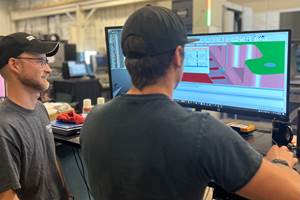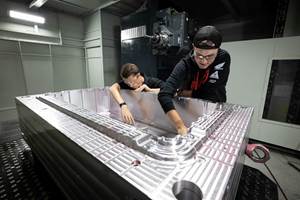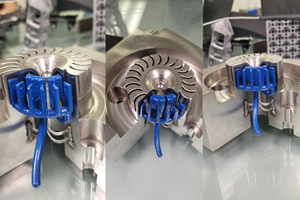Coupler Lends Easy, Reliable Solution to Quick Mold Change
A coupler helps provide a faster, more reliable way to tie positive return ejection into a mold.
Jeremy Fennelly was an intern at the University of Massachusetts Lowell back in 1992 when he answered an ad on the recruiting wall from Rubbermaid looking for engineers to work on a six-month system-integration project to help the company cut costs. The project entailed changing the configuration of the company’s manual tool-change process, which at the time used cranes and manual hookups into a side-table mold-change system.
The challenge was trying to figure out a way to decouple the ejector rods from the tool, which proved difficult with the waterline and manifold connection configuration that the company was using. Fennelly started researching options and came across an ad for couplers from Alba Enterprises (Alba).
“This coupler looked like it could fit the job with respect to size and durability. We were working on big molds for industrial trash cans, in 1500- to 2200-ton presses. I reached out to Alba, got some samples and figured out a solution,” Fennelly says.
The Alba couplers enabled Fennelly to develop a way to index the machine to offset it. That way, when the machine was in operation mode, the mold would stay forward and not pull the coupler all the way back to actuate the decoupling. Then when he was ready to remove the mold from the machine, he could index the coupler back further and a strip ring would automatically decouple it then recess the coupler back into the machine. Fennelly would then use a side table for mold pullout. “It used to take about six to eight hours to change a tool, and these couplers helped us cut that down to 30 minutes with tons of waterlines and connections,” Fennelly says.
Fennelly moved on years ago to become a senior principal engineer for Johnson & Johnson, but Rubbermaid still purchases a large amount of these couplers from Alba, proving the longevity of these couplers as a solution.
Later in 1994, the plant manager at Hospital Disposables Busse (Busse), Dean Cardinale, had a similar story. Back then, Busse had one of the largest presses that Arburg offered, an 85-metric-ton All Rounder hydraulic injection molding machine and molds with positive-return injection systems. At the time, Arburg had couplings that threaded into the ejector plate and then threaded into a thread on the ejector-bar side. But during mold clamping lockup, the tools go under compression. The hydraulic side of the ejector plate would flex during lockup and snap the couplers. There was no movement or room for flex at all. “Plus, it was arduous. The ejector bars had to be perfect and threaded the same way. It was very manual with proximity switches. There were no programmable Arburgs at that time,” Cardinale says.
So Cardinale and his team created different types of ejection systems to compensate for all this manual work. They used collar locks that were machined hollow, and then they used a regular bolt with a spring to accommodate the flex. It was very time-consuming and labor-intensive.
Eventually, the team invested in a next-generation Arburg molding machine on which operators could load diskettes for all their information. “It was a little computer. All of your movements (injection, nozzle, ejector, clamp) were done within encoded positions, allowing you to create zero positions,” Cardinale says. “But, I was fed up with these couplers because I still had to put on ejector bars. So, I started researching online and found couplers from Alba.”
This coupler is unique because when the operator puts the barb into the coupler, there is a little bit of a spring-loaded flex, which takes a lot of load off of the machine so that nothing gets snapped. It is that little bit of machining space that provides a necessary buffer. This helped eliminate any manually adjusted coupler breakage and required no threading, turning or lock screws. “You just bring it forward, click, bring it back, and you are done,” Cardinale says.
The Beauty of the Coupler
Now, the purpose of a coupler is to have a faster, more reliable method for tying positive-return ejection into the mold. Positive-return ejection requires some form of spring force to hold the ejection system in the back position, and spring pressure must be more than the pressure that is required to activate the couplers. However, the real question is: How does someone use a coupler? Cardinale decided to use the coupler in a very specific way (see the video above).
He took ejector bars from Arburg and contracted a toolmaker to manufacture small adapters that could fit the half 13 thread of the coupler, adapting the coupler to the ejector plate of the press. He then modified the ejector bars on both sides of the bars to adapt a new system. First, he put a corresponding threaded rod on one side of the ejector bar to thread into the mold’s ejector housing. Next, he threaded the other side of the ejector bar to match the thread of the barb, which facilitates the quick disconnect capability of the coupler. (This is a non-typical installation. See the animation simulation below for a typical installation.)
Then, once he clamped the mold in the press, the ejector bars were threaded into the ejector plate of the mold. In setup mode, he opened the mold to a safe distance in order to perform the quick disconnect sequence—the ejector plate comes forward and clicks right into the coupler. Then he moved the ejector plate back until it physically could not go back any further and hit a zero position on the machine to establish his zero point.
“I just wanted a positive-return ejector system, and this was the best way to do it,” Cardinale says.
Cardinale adapted this method to all the other presses. He notes also that it is important to size the barb so that it is no bigger than the ejector bar because that enables the operator to pull out the ejector bar without having to take off the barb.
Alba President and CEO Rich Oles says that older injection molding machines are not capable of producing an accurate ejection stopping position, decouple (using full ejector stroke) and recouple on the forward ejection stroke. “Here, it is beneficial to have positive ejector plate return (springs, for example) to prevent the ejector assembly from drifting forward and causing a collision with the end-of-arm tooling.”
This coupler is designed to provide a quick method of attaching the ejector plate in the mold to the ejection system in the molding machine. It also provides positive ejector plate return while greatly reducing setup time. This coupler is suited for molding machines where the ejector plate on the machine is difficult to reach and is ideal to use when center ejection is desired but impossible to tie-in.
Lean and Mean
Very early in Cardinale’s career, a plant manager gave him a book called “SMED,” which stands for Single Minute Exchange of Die, one of the many lean production methods for reducing waste in a manufacturing process. These couplings fit right into lean manufacturing by enabling the operator to change things more quickly, improve accuracy, ease setup and increase durability, Cardinale says. “Now everything is done with quick disconnects, which shaves off a lot of time from mold setups.”
Before the Alba coupler, Cardinale would break a couple of sets of couplers every two months, which can get expensive. Today, he runs molding machines five days a week, 24 hours a day, and the couplers last for years. “I can get five to eight years out of them. Plus, Alba has expanded its line to provide more flexibility in threads” Cardinale says. That is important because with every molding machine operators want to match the thread that they have. When they have to make adapters, they lose some of the stroke distance. Operators want to maximize the amount of stroke that they have for all their machines, so they want that coupling to be flush against that ejector plate. Being able to match the thread to the plate is paramount.
These couplers also have a hex socket for easier tightening to ensure that the couplers are seated properly. The hex socket makes this step a lot easier because couplers can be difficult in regard to fitting a wrench in the limited amount of space available to tighten the coupler into the plate. “The hex socket inside permits a hex socket bit with a 3/8 rachet inside to tighten them easily,” Cardinale says.
It is important here to ensure that the coupler and barb are seated against the knockout bar face and in the ejector-plate counter bore. “This distributes the force across a broad surface, ensuring long, trouble-free operation. Failures occur when the coupler is not seated, and the threads take the full force of the plate actuation,” Rich Oles says.
Cardinale also warns that the coupling must be flush to the plate and that the knockout bars should be cut to the same length. Specifications on Alba barbs and couplers are very tight. The beauty of that is that distances on the couplings for the tie-ins will yield very level, even pushing, retraction and ultimately no binding on the ejector assembly if the bars are cut exactly to spec. The result is extended ejector assembly life with fewer interruptions from failures. “The more you guide, the better you guide, and the evenness of the guiding of the forward and backward positions means less wear and tear,” Cardinale says, “Still today, if I'm using knockouts and ejectors, then I'm using those couplings.”
The bottom line is that it is time to seek out solutions like the right coupler if a shop is spending any measurable amount of time performing non-value-added functions, such as threading in-and-out knock-out bars and repairing damaged threads or coining in the ejector plate.. Let’s face it—the business of injection molding is selling time. So, the more time that a shop spends molding good parts, the less time it spends rescheduling, boosting the amount of its on-time deliveries and increasing how often it hits planned profits.
Related Content
How to Clean and Maintain Molds With Intricate Conformal Cooling Channels
A water-based, eco-friendly plastic mold cleaning system helps Rankine-Hinman Manufacturing restore flow rates and avoid big-ticket failures on complex and costly molds.
Read MoreCAD/CAM Software Reduces Delivery Times by 70% With a Six-Month ROI
Single integrated CAD/CAM package reduces translation errors, simplifies design process, improves shop efficiency and shortens tool lead times.
Read MoreHybrid Milling/Drilling Machine Reduces Total Mold Machining Time
MSI Mold Builders now squares, plus drills and taps eye-bolt holes on 50% of its tools in a single setup using a five-axis milling/drilling center with a universal spindle.
Read MoreLarge Hybrid Steel Insert Solves Deformation, Dimensionality, Cycle Time Problems
DMLS printers using metal additive powders selected by Linear AMS to produce high-quality, accurate, consistent 3D-printed mold components with certification and traceability.
Read MoreRead Next
Are You a Moldmaker Considering 3D Printing? Consider the 3D Printing Workshop at NPE2024
Presentations will cover 3D printing for mold tooling, material innovation, product development, bridge production and full-scale, high-volume additive manufacturing.
Read MoreHow to Use Strategic Planning Tools, Data to Manage the Human Side of Business
Q&A with Marion Wells, MMT EAB member and founder of Human Asset Management.
Read MoreReasons to Use Fiber Lasers for Mold Cleaning
Fiber lasers offer a simplicity, speed, control and portability, minimizing mold cleaning risks.
Read More





















